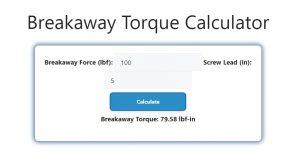About Breakaway Torque Calculator (Formula)
The Breakaway Torque Calculator is an essential tool in engineering and mechanical applications, allowing users to determine the torque required to initiate the movement of a threaded fastener. Understanding breakaway torque is crucial for ensuring that fasteners are securely tightened while also being able to be loosened when necessary. This calculator takes into account the breakaway force applied to the fastener, the lead of the screw, and the mathematical principles governing torque.
Formula
The formula for calculating breakaway torque is:
Breakaway Torque = Breakaway Force * Screw Lead / (2 * π)
Where:
- Breakaway Force is the force required to overcome the static friction of the threaded connection.
- Screw Lead is the distance the screw advances with one complete turn, typically measured in millimeters or inches.
- π (Pi) is approximately 3.14159, a constant used in circular calculations.
How to Use
Using the Breakaway Torque Calculator is straightforward and involves the following steps:
- Measure the Breakaway Force: Determine the amount of force needed to break the static friction of the screw connection, usually measured in newtons or pounds.
- Determine the Screw Lead: Measure the lead of the screw, which indicates how far the screw travels with one full rotation.
- Input Values: Enter the values of the breakaway force and screw lead into the formula.
- Calculate Breakaway Torque: Perform the calculation to obtain the breakaway torque value, ensuring proper fastener application and removal.
Example
For instance, consider a situation where a screw has a breakaway force of 100 newtons and a screw lead of 5 millimeters. Using the formula:
Breakaway Torque = Breakaway Force * Screw Lead / (2 * π)
Substituting the values:
Breakaway Torque = 100 N * 5 mm / (2 * 3.14159)
Breakaway Torque ≈ 100 * 5 / 6.28318
Breakaway Torque ≈ 79.577 N·mm
In this example, the breakaway torque required to loosen the screw is approximately 79.577 N·mm.

FAQs
- What is breakaway torque?
Breakaway torque is the amount of torque required to overcome static friction and initiate movement in a threaded fastener. - Why is breakaway torque important?
Understanding breakaway torque ensures that fasteners can be securely tightened while allowing for safe and easy removal. - How is breakaway force measured?
Breakaway force can be measured using a force gauge or by applying a known load until the fastener moves. - What units are used for screw lead?
Screw lead can be measured in millimeters (mm) or inches (in), depending on the screw’s specifications. - Can this calculator be used for any type of screw?
Yes, the calculator can be used for various types of threaded fasteners, including bolts, screws, and nuts. - What happens if the breakaway torque is too high?
Excessively high breakaway torque may indicate over-tightening, which can lead to thread damage or failure. - How do I know if I have the correct screw lead?
The screw lead can be found in the screw’s technical specifications or by measuring the distance the screw advances in one full rotation. - Can breakaway torque vary with lubrication?
Yes, lubrication can significantly reduce the breakaway torque by decreasing friction between the threads. - What tools can I use to measure breakaway torque?
A torque wrench or a torque screwdriver can be used to measure and apply the correct breakaway torque. - Is breakaway torque the same as running torque?
No, breakaway torque refers to the torque needed to start movement, while running torque refers to the torque needed to maintain movement. - How does temperature affect breakaway torque?
Temperature changes can alter the properties of materials and lubricants, potentially affecting breakaway torque. - What should I do if I can’t achieve the required breakaway torque?
Ensure that the screw is not cross-threaded, check for obstructions, and verify that the correct force is being applied. - Is there a maximum allowable breakaway torque?
Yes, manufacturers typically specify maximum allowable torques to prevent damage to fasteners or assemblies. - Can breakaway torque calculations be done without a calculator?
Yes, you can manually calculate breakaway torque using the provided formula, but a calculator makes it quicker and easier. - What materials affect breakaway torque the most?
Materials with high friction coefficients, such as certain metals, typically require higher breakaway torque. - Can I use this calculator for hydraulic fasteners?
While the basic principles apply, hydraulic fasteners may have additional considerations that need to be taken into account. - What is the effect of rust on breakaway torque?
Rust can increase friction, requiring higher breakaway torque to loosen the fastener. - How often should I check breakaway torque for critical applications?
It’s recommended to check breakaway torque periodically or after any maintenance that could affect the fasteners. - Are there safety concerns with breakaway torque?
Yes, using excessive force to break a fastener can lead to injuries or equipment damage. Always use appropriate tools. - Can I calculate breakaway torque for non-threaded connections?
This calculator specifically applies to threaded fasteners. Non-threaded connections may require different calculations.
Conclusion
The Breakaway Torque Calculator is an invaluable tool for anyone working with threaded fasteners, providing essential information for achieving optimal tightening and loosening conditions. By accurately calculating breakaway torque, users can enhance safety, prevent equipment damage, and ensure the longevity of threaded connections. Understanding the factors influencing breakaway torque, including breakaway force and screw lead, allows for better management of fastening applications in various industries.
